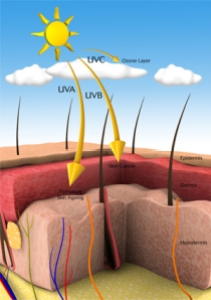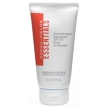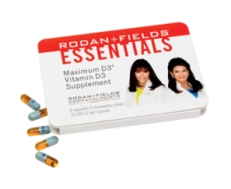by Debi G | Apr 28, 2014
 The phenomenon known as the “paradox of sunscreen” pertains specifically to UVA light. In spite of the widespread use of sunscreen over the past 30 years, photoaging and skin cancer rates have continued to rise. If sunscreens were effectively protecting us, this would not be the case.
The phenomenon known as the “paradox of sunscreen” pertains specifically to UVA light. In spite of the widespread use of sunscreen over the past 30 years, photoaging and skin cancer rates have continued to rise. If sunscreens were effectively protecting us, this would not be the case.
The reason this phenomenon exists is the false sense of security people often get from using sunscreen. While a high-SPF sunscreen might prevent a UVB-induced sunburn, it doesn’t necessarily offer the same protection when it comes to UVA rays. So, thanks to a product with an SPF 30, you might have spent three to four times longer in the sun, believing you were protected. However, if your sunscreen blocked mainly UVB light and, to a much lesser extent, UVA light, you could easily have been exposed to three to four times more UVA light. Because UVA light is present in one-hundred-fold greater amounts in the environment than UVB light, the profound damage that is associated with UVA, such as premature aging and melanoma, has been on the rise.
Fortunately, new sunscreen rules are designed to address the paradox of sunscreen with a new efficacy testing for “broad-spectrum” label claims. As of December 2012, in order for a sunscreen to claim broad-spectrum activity, it must demonstrate effective UVA protection in proportion to its SPF claim. If a sunscreen does not pass the broad-spectrum test, it is required to bear a warning that reads, “Skin cancer/skin aging alert: Spending time in the sun increases your risk of skin cancer and early skin aging. This product has been shown only to help prevent sunburn, not skin cancer or early aging.”
Keep in mind that even with the best SPF you still need to be sun smart. That means generously reapplying sunscreen throughout the day and seeking shade as often as you can when you are outdoors.
Be smart and use Rodan+Fields sunscreens…we’ve got you covered! (click on the image below)
FOR YOUR BODY: 
FOR YOUR FACE: 



For Your Questions:
by Debi G | Apr 21, 2014
 “Base tan” is a term popularized by tanning salons and refers to the practice of gradually developing a sun tan through sun exposure or a tanning bed, often before a tropical vacation or other sun-soaked event. The thinking is that somehow, this can prevent a sunburn or sun damage.
“Base tan” is a term popularized by tanning salons and refers to the practice of gradually developing a sun tan through sun exposure or a tanning bed, often before a tropical vacation or other sun-soaked event. The thinking is that somehow, this can prevent a sunburn or sun damage.
Unfortunately, this just isn’t true. The UV rays that tan your skin in a tanning bed are identical to the UV rays that come from the sun. Most alarming, research based on seven worldwide studies has shown that people who first use a tanning bed before age 35 increase their risk for melanoma by 75%.
Sun protection is the single most important way to keep your skin looking young and healthy. However, if you have a history of basking in the sun, don’t despair. There are many options to protect yourself today and plenty of techniques to reduce and reverse the signs of sun damage you may already have. Start by using your sunscreen every day. Your skin will thank you for it and it could save your life.
Products we recommend: Contact Me For More Information
Contact Me For More Information
by Debi G | Apr 15, 2014
 People believe that sun helps to clear up their acne because a tan masks the redness of a breakout and may in fact dry pimples up a bit faster.
People believe that sun helps to clear up their acne because a tan masks the redness of a breakout and may in fact dry pimples up a bit faster.
However, over time, sun exposure causes breakouts rather than clears them. With every tan, cell turnover increases, building up more dead cells. As these dead cells pile up, pores become blocked, causing more breakouts. And perhaps a higher risk of skin cancer, not to mention premature wrinkles and brown spots!
 The best way to treat breakouts is with regular use of a clinically proven acne solution. Such as the Unblemish Regimen from Rodan+Fields. Don’t let the sun cause other problems for your skin when you can easily get control over those nasty breakouts!!
The best way to treat breakouts is with regular use of a clinically proven acne solution. Such as the Unblemish Regimen from Rodan+Fields. Don’t let the sun cause other problems for your skin when you can easily get control over those nasty breakouts!!
Message me today for your trouble free skin!
by Debi G | Apr 11, 2014
 Vitamin D is a fat-soluble vitamin that prevents rickets in children, maintains bone density in adults, may inhibit certain cancers such as non-Hodgkin’s lymphoma and possibly lessens the risk of diseases such as multiple sclerosis.
Vitamin D is a fat-soluble vitamin that prevents rickets in children, maintains bone density in adults, may inhibit certain cancers such as non-Hodgkin’s lymphoma and possibly lessens the risk of diseases such as multiple sclerosis.
There is an ongoing debate in the medical community that daily sun exposure is critical for production of adequate vitamin D. It is true that sunlight stimulates the production of vitamin D; however, the Skin Cancer Foundation recommends that you get your daily value of vitamin D from non-sun sources, such as vitamin D–fortified milk, orange juice, salmon and other fatty fishes or a multivitamin containing at least 1000 international units of vitamin D3daily.

For More Information:
 The phenomenon known as the “paradox of sunscreen” pertains specifically to UVA light. In spite of the widespread use of sunscreen over the past 30 years, photoaging and skin cancer rates have continued to rise. If sunscreens were effectively protecting us, this would not be the case.
The phenomenon known as the “paradox of sunscreen” pertains specifically to UVA light. In spite of the widespread use of sunscreen over the past 30 years, photoaging and skin cancer rates have continued to rise. If sunscreens were effectively protecting us, this would not be the case.







 People believe that sun helps to clear up their acne because a tan masks the redness of a breakout and may in fact dry pimples up a bit faster.
People believe that sun helps to clear up their acne because a tan masks the redness of a breakout and may in fact dry pimples up a bit faster.

